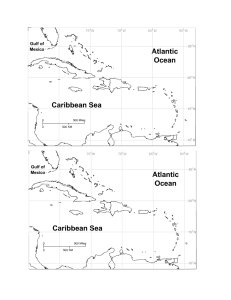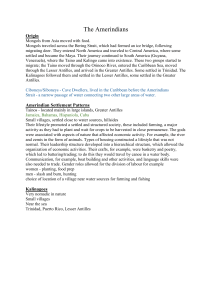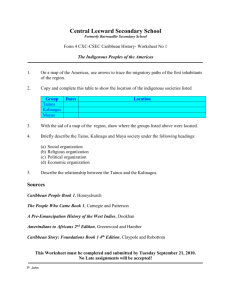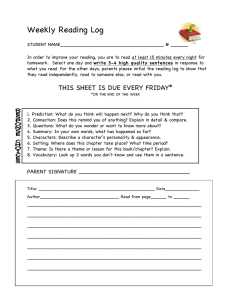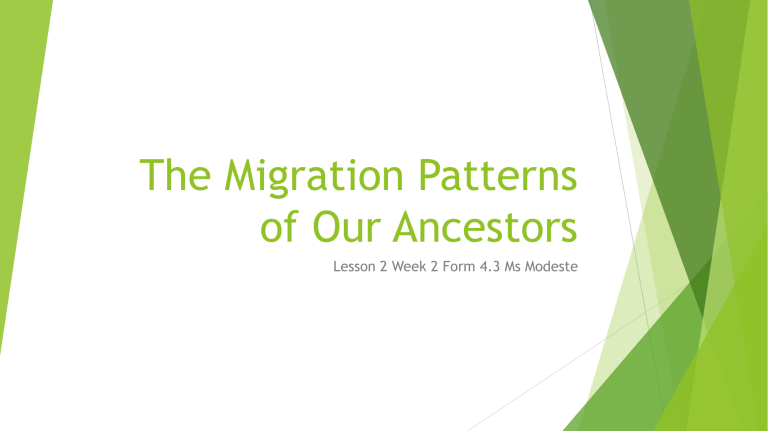
The Migration Patterns of Our Ancestors Lesson 2 Week 2 Form 4.3 Ms Modeste Definition of Migration Migration is a mass movement of people from one place to another displaced voluntary or involuntary due to factors within their home environment. The ancestors of our indigenous people crossed the Bering Strait in Russia Siberia or Asia. A strait is a narrow passage of water connecting two large areas. The Strait was frozen and the indigenous people chasing herds of buffalo for food, were unaware that they were crossing this Beringa Land bridge from Russia/Siberia Asia into Alaska (USA). World Map: Find the Bering Strait. Bering Strait: Russia/Siberia INTO Alaska/North America/USA A strait is a narrow passage of water connecting two seas or other large bodies of water Migration from the Bering Strait into North America and South America 1.North America/USA This migration pattern occurred almost 13,500 years ago starting in N. East Asia/Siberia/ Russia into North America/Alaska. Each step would have taken centuries. Tribes settled and were known by various names: Algonquin,Cherokee, Choctaw, Inuit, Apache, Iroquois. 3. The Caribbean They settled in Orinoco Basin Guyana first then came into Caribbean Taino: Greater Antilles Kalinago: Lesser Antilles 2.Central /South America: Mayans: Belize, Mexico Aztecs: Mexico Migration & Settlement of Caribbean Tribes: Kalinago and Taino Taino settled here in the Greater Antilles In the Caribbean: The warlike Kalinago would have chased the peaceful Taino up further until the Taino settled in the GREATER ANTILLES As a result, the Kalinago settled in the LESSER ANTILLES Kalinago settled here in the Lesser Antilles Class Activity Notes: Fill in the blanks. The indigenous people originated in__________________ crossing the ice bridge covering the _________________ following herds of buffalo into Alaska/ _______________________. Over centuries they wandered further into North America. Two North American tribes were known as the Sioux and Apache. Migration continued as they headed further south into____________________ America. The group that settled in Central America (Mexico, Belize, Honduras) was known as the Mayan and Aztec tribes. The Incas settled in Peru(South America). Those who migrated to the Caribbean, first settled around the ______________Basin Guyana. They then entered___________________ from which they moved northward, into the _______________Antilles and ______________________Antilles. The warlike ______________ chased the peaceful ___________ further up the archipelago into the Greater Antilles causing the Taino to settle there while the Kalinago stayed in the __________ Antilles. There were some islands occupied by both groups namely Trinidad, St Vincent and Puerto Rico. EXAMINING INDIGENOUS GROUPS ACCORDING TO CATEGORIES: POLITICAL ORGANISATION: Leadership hierarchy, Rulers, government. SOCIAL ORGANISATION: Class Structure, Dress, Religion, Recreation, Housing, Culture, Food Eaten. ECONOMIC ORGANISATION: Trade, Fishing, Agriculture, Earning a Livelihood Testing our understanding: Which of the following sentences are Political, Social and Economic. 1. The Mayan people stored their agricultural harvest in a chultune__________ . 2. The Kalinago men lived separately from the women._______________ 3. A cacique was the Taino leader who had many functions______________. 4. Taino art could be seen in all aspects of their daily life _______________. 5. The naming of babies and a caciques wedding was always celebrated_______. 6. Kalinago believed in evil spirits called maboya. 7. The test of Kalinago manhood was to be scrapped with an agouti claw______. 8. The Mayans had elaborate headdresses of feather and gold_______________. 9. The role of the Kalinago ubutu leader was to lead in warfare_____________. 10. The Kalinago earned a living by excelling at trading.___________________ Sighting these terms in History: Where else will you see these terms Social, Political, Economic in History? Everywhere! Political Economic Social Can also be used in other many topics of history such as Emancipation, Federation, Sugar revolution. What was the economic, social, political reason for emancipation? What were the social consequences of the sugar revolution? What were the political reasons for Federation? Be aware of what it means! Our Direction Quick Glance of Syllabus and Exam Paper: Kalinago, Taino and Mayan People One THEME is chosen for each section. A theme is where the teacher must do an INDEPTH teaching of the topic. All other topics are considered Core where teachers are NOT required to teach indepth but just prepare the student for Paper 1 Multiple Choice which comes on ALL topics. Sec A Theme 1 Indigenous People and the Europeans (OUR THEME-in depth) Sec A Theme 2 Caribbean Economy and Slavery ( our theme-in depth) Sec A Theme 3 Resistance and Revolt (Core) Sec B Theme 4 Metropolitan Movements toward Emancipation (OUR THEME) Sec B Theme 5 Adjustments to Emancipation (1838-1876) (Core) Sec B Theme 6 Caribbean Economy (1875-1985) (Core) Sec C Theme 7 The United States in the Caribbean 1776-1985 (Core) Sec C Theme 8 Caribbean Political Development up to 1985 (OUR THEME) Sec C Theme 9 Caribbean Society 1900-1985 (Core) We have no time to waste! Class hrs have already been cut with Covid. We await CXC to adjust syllabus. We have: Form 4: Three (3) terms Form 5 Two (2) terms EXAM STRUCTURE: Section A- Short answers on Theme Section B- Essay on Theme Section C-Essay on Theme Group project/presentation The class will be divided into TWO teams: One team will be researching the Mayan people and other the Taino people. Presentations must be done on Power point or Word document (yet to be decided according to student’s resources) and must cover all aspects of Political, Economic and Social of each indigenous group: dress, weapons, leaders etc. A part will be assigned to everyone. Two/three persons from the team will be assigned team organisers to collect and put slides or word doc together whichever is most practical for organisers (for additional marks) . One will collect, one will be liaison with teacher to report any difficulties. Team organisers will also have to liaise with each other. Each student is responsible for submitting their 1-3 slides or word doc or info via email to the team organisers. Put the link or book&author where you sourced the information at bottom of slide or page. Put your name at the bottom of the slides or word doc you have done. Please include 2 pictures. Team organisers if there is anyone who is not contributing or who has not submitted slides or word docs please email me mshistorymodeste@gmail.com. All students must be there to present their research. Mark allocation per student: Research/Accuracy 15 marks, Creativity 10 marks, Delivery 5 Project Groups A and B GROUP A: The Tainos (Students please ensure all names are here once you are online) Members Area of Research Nshaun Ambrose Location, Time Tyler Ayers Appearance built/Dress Aniyah Blackman Social: Religion Nathaniel Carrim Social: Housing Omega Chow Social- Diet/Favourite Dish/Not eat Celine Deeposingh Economic- Fishing, Agriculture Crops Grown Zuriel Durham Political- Leadership. Chosen/Name/Duties Jadon Durity Social-Recreation/Celebration activities Tenisha Dyer Social-Religion (2) Jenine Edmund Social-Culture/Artefacts/pottery/Weaving GROUP B: THE MAYAN PEOPLE (Students please ensure all names are here if you are online) Group Members Area of Research Victoria Francis Political/: Leadership/How selected/ Duties/Social Classes Olesha Hannanway Social: Religion Maya-Michelle Khan Two Achievements Farouk Mohammed Economic: Agriculture/Food Jayden Moore Two Achievements (2) Jenia Roberts Social-Culture/Artefacts & Dress Kevin Rougier Social: Games/Recreation Ricardo Skinner Location/Time/Era Isha St Louis Economic: Trade Eden Thompson Warfare Mariah Lalla Two achievements (2) Group Organisers for Presentations: Group A: Taino Omega Celine Tyler Zuriel Group B: Mayan People Olesha Jenia Farouk Maya Additionally everyone send me an email from your active address (gmail): “Why I choose Class 4.3 Modern Studies subject groupings” 2 paragraphs by Friday (15marks), so I can save your addresses and pass on to organisers. Assignment List the islands in the Lesser Antilles starting with Trinidad. List all the islands in the Greater Antilles Download and print a picture of the Caribbean Region. Circle the Greater Antilles and put T for Taino at the top of circle. Circle the Lesser Antilles and put K for Kalinago. Encircle Mexico, Guatemala, Belize, W. Honduras and put M for Mayan people Give three likely reasons why ANY indigenous group will most likely migrate. Start reading your text Chapters 1-3
